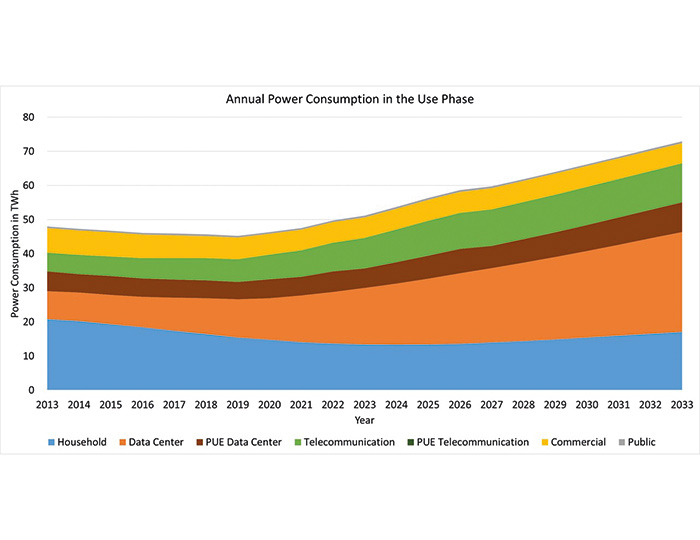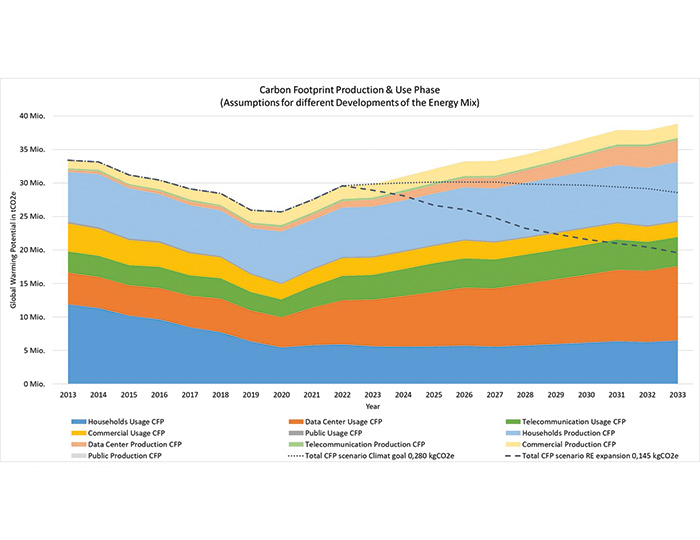RealIZM blog series »Green ICT« – Part 2
There are currently signs of a trend reversal in the demand for electricity in ICT. According to calculations carried out by Fraunhofer IZM, the annual demand for electricity in ICT is rising again since 2023, from around 50 TWh to over 72 TWh in 2033. In a recent study, Dr. phil. Lutz Stobbe and his team model the environmental impact of the production and use of information and communication technologies (ICT) in Germany over a period from 2013 to 2033. The ICT study was commissioned by the Federal Ministry of Education and Research (BMBF)
Rising energy demand and bigger carbon footprint in the use of ICT
The Fraunhofer IZM study on the energy demand and carbon footprint in the manufacture and use of household appliances, data centers and telecommunications networks is part of the joint project »Green ICT @ FMD«. The ICT study shows that despite signs of progress in the areas of miniaturization, system integration and energy management and an improvement in the energy mix, the increasing demand for electricity in the use phase of ICT continues to drive up the carbon footprint (CF).
- The annual energy demand of ICT in Germany rises from approx. 50 TWh (2023) to approx. 72 TWh (2033).
- The annual carbon footprint for the production and use of ICT in Germany grows in the conservative energy mix scenario, from around 30 million tCO2e in 2023 to 38 million tCO2e in 2033. If the targets for the expansion of renewable energy in Germany are achieved, this trend could change significantly, allowing the carbon footprint to drop below 20 million tCO2e in 2033.
The demand for electricity from household appliances amounted to approx. 19 TWh in 2013 and dominated total emissions in the use phase (60%). The demand for electricity declined in the following years and fell to around 13 TWh by 2023. There are many reasons for this positive trend. The measures under the European Ecodesign Directive, which sets limits for standby and maximum electrical power consumption for many product groups, among other things, substantially impacted this. This legislative pressure certainly also led to a corresponding development in technology. Finally, the shift towards almost complete digitalisation in consumer electronics also reduced electricity consumption.
Despite these measures, the electricity demand for ICT in households will rise slightly again in the medium term, to around 15 TWh in 2033. Larger displays and televisions with very high resolutions and refresh rates, more powerful computers and the wireless networking of smart end devices are contributing to this trend. Smaller ICT products such as smartphones, smartwatches and loudspeakers have comparatively low power consumption despite the large number of these units.
The carbon footprint for the manufacture of these end devices is also expected to increase in the medium term, from less than 7 Mt CO2e today to around 9 Mt CO2e in 2033. The causes of this negative development are manifold. The production of integrated circuits (ICs) and displays in clean rooms is a major cause. With growing amounts of memory and larger displays, resource requirements, energy consumption and direct emissions will continue to rise despite the technological and manufacturing advances made. It is difficult to influence this development from a German perspective, as almost the entire supply chain is located in Asia and America. The use of renewable energies in component production could easily lead to a positive trend reversal. However, such a scenario has not yet been factored into the model.
From conservative to ambitious: scenarios for sustainable CO2 reduction
To calculate the carbon footprint for the use phase, calculations were carried out for three scenarios that made different assumptions on the development of the German energy mix:
– Scenario 1: conservative development with a gradual reduction in the electricity mix from 434 gCO2e/kWh (2022) to 380 gCO2e/kWh (2030)
– Scenario 2: progressive development to achieve the federal government’s climate protection targets with a gradual reduction in the electricity mix from 434 gCO2e/kWh (2022) to 280 gCO2e/kWh (2030)
– Scenario 3: ambitious development to implement the energy transition with a gradual reduction in the electricity mix from 434 gCO2e/kWh (2022) to 145 gCO2e/kWh (2030)
The main driver of the increase in electricity consumption is the ICT infrastructure, i.e. the telecommunications networks and data centers, which account for the majority of digitalization. The energy demand of data centers has been growing continuously since 2013, from 7.5 TWh (2013) through 15 TWh (2023) to 27 TWh (2033). While the carbon footprint for data center use was around 4.3 tCO2e in 2013, it rises to around 10.3 tCO2e (2033) in the conservative scenario.

This graph depicts the electricity demand in the use phase and shows that this has been increasing for data centers and telecommunications since 2020. | © Fraunhofer IZM *As of 4/2024: Model version ICT_CF_D_Mod_24-2
Internet-based services, the increasing use of artificial intelligence (AI) and machine learning (ML) mean that ever more powerful processors, working memory and long-term storage are required in data centers, the operation and cooling of which increase energy demand.
Whereas in the past, processors required around 150 watts of power, modern processors with many cores and super-fast clock frequencies for AI and ML applications require around 300 and up to 700 watts. The rapidly growing demand for RAM will also generate visible power consumption in the medium term. Finally, the computer systems in the data centers must also be networked with each other and connected to the outside world. This necessity leads to an expansion of the data transport capacities of switches, routers and gateways. This current development will also be visible in electricity requirements in the medium term and will contribute to the increase.
The environmental impact of telecommunications networks is increasing at a weaker pace than that of data centers, although long-term growth in electricity demand is also clear here. The gradual modernisation of telecommunications networks has so far offset many of the negative effects of the annual increase in data transport volumes. Forecasts for the development of data traffic are very heterogeneous. While the statistical development published annually by the Federal Network Agency continues to show falling growth figures and thus a slight slowdown in the increase in data volume, there is uncertainty surrounding the question of how high-resolution ultra HD video streams, massive AI use by end users and ML-based cloud services will affect data traffic.
Telecommunications networks are being designed for peak performance in order to ensure the simultaneous transmission of major events such as a soccer World Cup and current political developments. This intrinsic oversizing of the telecommunications grids means that load fluctuations in grid electricity demand is almost invisible. However, the expansion of 4G and 5G mobile networks is clearly visible. The associated network densification is reflected in rising energy demand.
Grid electricity demand amounted to around 5.2 TWh in 2013. Since then, it has been growing slowly: 8.4 TWh (2023) and 10.3 TWh (2033). According to preliminary calculations, the carbon footprint for the use phase of telecommunications technology will only increase very slightly from 3 million tCO2e (2013) to 3.9 million tCO2e (2033). The modelling of the environmental impact of telecommunications technology has not yet been completed.
Increase in the environmental impact of communication networks, servers and data centers
In their forecast, the environmental experts at Fraunhofer IZM also come to the conclusion that a third of the carbon footprint results from ICT production. Production mainly takes place in Asia, limiting Germany’s direct influence over environmental issues in the manufacturing process.

This graphic shows the development of the carbon footprint for individual sub-areas such as data centers, as well as the overall CO2 development depending on scenario 2 & 3. *As of 4/2024: Model version ICT_CF_D_Mod_24-2
The main causes of the increasing CF in the manufacturing phase are:
- The demand for semiconductor-based storage capacity (SSDs) and more powerful CPUs with a lot of DRAM is increasing. As a result, the total chip area in data centers is also increasing, the production of which is very environmentally intensive.
- Increasing display sizes in smartphones, laptops, monitors and televisions lead to a high CF in production. Smaller gadgets such as wearables, headphones and USB sticks have a relatively low CF in the manufacturing phase. However, these core wearables influence the CF for the production of all ICT used in Germany due to their high sales volumes.
- The conversion of radio and wired access networks primarily determines the CF in telecommunications network manufacturing. There are no LCA data sets for III-V semiconductors, high-frequency materials and special passive components. A precise quantification of this carbon footprint is therefore still pending.
Sustainable ICT: from energy transition to technological change
The ICT study provides sound information for making sustainable decisions for the development of green electronics. Research institutions and manufacturers of electronic products therefore have a big responsibility to develop high-quality, reliable and sustainable technologies and products. In addition, information on the environmental impact of electronics production helps companies and policymakers to set the course for green information and communication technologies (ICT).
Users can also contribute to this: by adjusting just a few settings, such as changing the resolution and reducing the brightness of screens, it is possible to save electricity and reduce the carbon footprint, explains Dr. phil. Lutz Stobbe:
Data centers are the driving force behind ICT’s increased energy requirements. But even small changes in our own usage behavior can contribute to achieving climate protection goals. A certain level of data hygiene and conscious minimisation of daily digital storage, for example, reduce the storage requirements in the cloud, as most data is backed up redundantly several times.
Changing the way in which we use digital media and services is just the beginning. To make ICT sustainable in the long term, technological changes also have to be made. One current development is the increasing implementation of liquid cooling systems in large data centers. Liquid cooling systems are very efficient, require less additional power and allow computer systems to be used more intensively. Liquid cooling systems can also be used to transport waste heat from ICT in data centers more effectively, making it usable for external applications.
Another technology trend with strong energy-saving potential is silicon photonics. This process enables highly effective end-to-end optical data transport. New materials will not only improve optical communication, but will also ensure further energy efficiency gains in the area of integrated circuits in the medium term. The high miniaturization of semiconductor-based components is becoming increasingly complex and expensive. This is why engineers are now developing complex three-dimensional systems made up of many small semiconductor chips that are high-performing and energy-efficient. Hetero-system integration technologies are crucial for sustainability in modern ICT systems.
Data basis of the ICT study: mapping technological and market-related developments
The sustainable electronics experts analyzed a total of 80 product categories for the ICT study.
The model incorporates a complex device inventory model that maps technological and market-related developments. The product spectrum covered includes ICT devices and systems in German telecommunications networks, data centers, private households, offices and businesses as well as in public spaces and industrial applications, explains Dr. Lutz Stobbe.
An average product was first defined for each product group based on attributes such as display size, memory and processor performance. The inventory in Germany was then extrapolated using sales figures. The lifespan of the product was also estimated. These data sets are required to create precise base models.
Green ICT @ FMD
The Green ICT Competence Center at the Research Fab Microelectronics Germany (»Green ICT @ FMD«) is a central point of contact for sustainable electronics. The Federal Ministry of Education and Research supports the project as part of the Green ICT initiative, which is part of the German government’s 2030 climate protection programme.
Network coordinator:
FMD office
Partners:
Fraunhofer EMFT, Munich; Fraunhofer ENAS, Chemnitz; Fraunhofer FHR, Wachtberg; Fraunhofer HHI, Berlin; Fraunhofer IAF, Freiburg; Fraunhofer IIS, Nuremberg; Fraunhofer IISB, Erlangen; Fraunhofer IMS, Duisburg; Fraunhofer IPMS, Dresden; Fraunhofer ISI, Karlsruhe; Fraunhofer ISIT, Itzehoe; Fraunhofer IZM, Moritzburg; Ferdinand-Braun-Institut GmbH, Berlin; IHP GmbH, Frankfurt (Oder)
BMBF funding
Duration:
08/2022-01/2026
*As of 4/2024: Model version ICT_CF_D_Mod_24-2
This could be interesting for you:
- RealIZM-blog series »Green ICT« – Part 1
Expert knowledge, just a click away: training videos on green electronics - ICT: How can digital technologies become greener?
Subscribe to RealIZM Newsletter!
Get the latest insights into electronic-packaging and innovative technologies in microelectronics deliver


